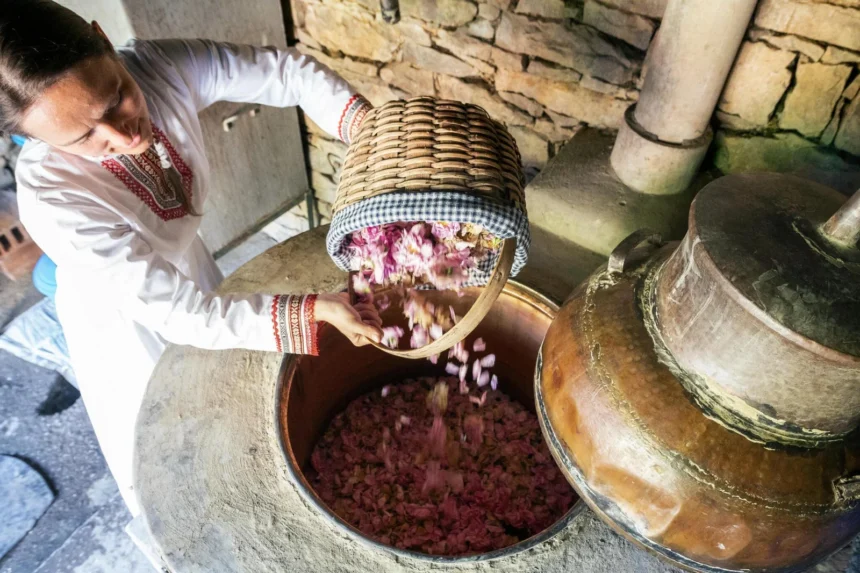Food is far more than mere sustenance. It embodies who we are, tracing back to our roots and traditions that have been passed down through generations. Each corner of the globe boasts culinary practices that not only shape societies but also celebrate heritage, forging connections among people in uniquely profound ways.
Recognizing the critical role food plays in our shared human experience, UNESCO has honored 30 culinary traditions with the title of Intangible Cultural Heritage.
Through my journey delving into international cuisines, I’ve come to appreciate how deeply food is intertwined with identity and culture. This exploration isn’t merely about savoring various dishes; it’s a pathway to understanding the rich narratives they carry about our collective histories and individual selves.
Allow me to share insights from this voyage—consider it your passport to discover a world brimming with flavors and stories waiting to be told.
Key Takeaways
- Foods like Ukrainian Borscht and Neapolitan Pizzaiolo show the world’s diverse culinary heritage. UNESCO honors these traditions for their cultural importance.
- Sharing traditional recipes keeps our history alive. Families pass down these treasures, teaching the young about their roots.
- Traditional dishes are not just tasty but healthy too. They use natural ingredients that are good for us, such as in the Mediterranean diet.
- Chef Anna Richardson uses her expertise to explore how food shapes cultures worldwide. She believes in respecting where food comes from and its sustainability.
- Learning about different foods can help us understand and accept other cultures better. But we must be careful to respect these traditions and not misuse them.
The Importance of Food Culture
Food culture plays a vital role in shaping our identities and connecting us to our heritage. Through the flavors and traditions of traditional cuisines, we can understand the impact of culture on food.
Defining food culture
Food culture is a rich tapestry that encompasses the culinary practices, traditions, and behaviors surrounding food preparation and consumption within a community or society. It includes everything from what people eat, and how they prepare it, to the traditions tied to certain foods.
We cherish our encounters with various food cultures around the world as we explore traditional cuisines. These experiences not only tantalize our taste buds but also deepen our appreciation for diverse flavors and traditions.
Through UNESCO’s recognition of 30 culinary traditions as Intangible Cultural Heritage, we realize the importance of preserving these flavorful heritages. Our journey through different continents has shown us how food acts as a cultural ambassador, weaving together stories and identities that are unique to each nation.
From savoring Ukrainian Borscht to enjoying Neapolitan Pizzaiuolo in Italy, we engage firsthand with dishes that have been passed down through generations, celebrating not just a meal but an entire culture’s way of life.
Impact of culture on food
Moving from defining food culture to the impact of culture on food, we can witness how traditional culinary practices vividly reflect cultural richness. The intersection of different cultures has significantly shaped the world’s foodways, resulting in a diverse tapestry of flavors and cooking techniques.
From UNESCO-designated intangible cultural heritages to national dishes serving as ambassadors, the influence of culture on food is unmistakable. This impact resonates through unique cooking methods, indigenous ingredients, and historic recipes that have been meticulously passed down through generations.
Cultural exchange through food continues to play a vital role in shaping global cuisine. Each dish carries with it an extensive heritage story that reflects not only regional diversity but also historical narratives.
Significance of food culture
As we explore the significance of food culture, it becomes evident that food is an integral part of cultural identity and heritage. The culinary traditions passed down through generations encapsulate stories, beliefs, and values unique to each culture.
These traditional meals not only symbolize a region’s flavors but also serve as a testament to its history and social customs. A prime example can be found in the 36 national dishes across the globe designated as cultural ambassadors, representing the rich tapestry of diverse culinary heritages.
The relationship between food and culture is undeniable; it underpins societal norms and serves as a bridge for cultural exchange globally. Traditional lunches are more than just meals – they embody centuries-old practices steeped in tradition, reflecting the soul of a community or nation.
Food and Identity
Food reflects a person’s identity and connects them with their heritage. It also plays a pivotal role in cultural traditions.
How food reflects a person’s identity
Our food reflects who we are. Our cultural background, traditions, and personal experiences shape the flavors and ingredients that define our culinary identity. For instance, African American culinary traditions are deeply rooted in the historical journey of the community, seen in dishes like soul food and Gullah cuisine.
These recipes carry stories of resilience and survival from generations past, serving as a tangible link to their identity.
Similarly, exploring Israel’s diverse range of dishes unveils a rich tapestry of flavors stemming from various cultural influences – be it Ashkenazi, Sephardic, or Mizrahi Jewish cuisines.
Each dish not only celebrates its unique heritage but also symbolizes unity within Israel’s multicultural society while preserving individual identities through flavor combinations passed down across generations.
Moreover, New Orleans’ Creole and Cajun cuisines encapsulate centuries-old amalgamations of French, Spanish, African, and Native American roots infused with local ingredients like okra and file powder.
Food as a means of connecting with one’s heritage
Food serves as a powerful tool for connecting with one’s heritage, reflecting the deep-rooted traditions and cultural identities of communities. Our food holds the key to understanding our past, present, and future as it embodies stories passed down through generations.
By savoring traditional dishes and sharing culinary rituals, we actively participate in preserving our heritage and shaping our cultural narrative. The act of preparing and consuming these cherished recipes creates a sense of belonging that transcends geographical boundaries.
Exploring indigenous ingredients and cooking methods can unveil a wealth of historical knowledge embedded within our culinary practices. Through this exploration, we gain insight into the ways in which cultural values are enshrined in the flavors and aromas of our traditional meals.
The role of food in cultural traditions
Food plays a crucial role in shaping the cultural traditions of different societies. It is not merely sustenance; rather, it serves as a reflection of the unique identity and heritage of each culture.
Through regional dishes and local cooking styles, communities showcase their distinct flavors and culinary techniques that have been passed down through generations. This is evident in UNESCO’s recognition of 30 culinary traditions as Intangible Cultural Heritage, highlighting how food embodies the complexities and richness of cultural gastronomy around the world.
These heritage foods serve as a powerful tool for connecting with one’s roots, preserving traditional cooking methods, and sharing authentic recipes that encapsulate ethnic cuisine.
Exploring the realm of food culture around the world unveils the secrets behind how traditional flavors underpin cultural exchange and connectivity. The fusion of different culinary traditions not only reflects multicultural societies but also offers insight into diverse foodways that have shaped nations’ identities throughout history.
Safeguarding Traditions Through Food
Preserving culinary traditions safeguards cultural heritage and promotes the continuation of traditional recipes, encouraging users to read more.
How traditional dishes preserve cultural heritage
Traditional dishes preserve cultural heritage by serving as edible artifacts, embodying the history, values, and customs of a community. These dishes act as living representations of a culture’s identity and traditions, carrying forward age-old recipes that have been passed down from generation to generation.
The preparation and consumption of traditional foods provide a tangible link to the past, allowing individuals to connect with their roots and take pride in their cultural heritage.
For example, UNESCO has recognized several culinary traditions as Intangible Cultural Heritage, underscoring the profound impact that food has on preserving cultural legacies.
Moreover, traditional dishes play a pivotal role in safeguarding indigenous knowledge systems related to cooking techniques, ingredient sourcing, and culinary rituals. They encapsulate the essence of diverse societies and reinforce collective memories while celebrating regional diversity through distinctive flavors and presentations.
The passing down of recipes from generation to generation
Recipes are passed down through generations, preserving cultural heritage and traditions. The act of passing down recipes not only connects individuals to their ancestors but also acts as a means of safeguarding culinary traditions.
This practice ensures that the flavors, techniques, and stories behind traditional dishes are carried forward, contributing to the continuity of cultural identity and heritage. For example, in African American culinary traditions, recipes have been meticulously preserved and handed down through generations, creating a rich tapestry of flavors that reflect their cultural history.
Preserving traditional recipes is crucial for maintaining cultural authenticity and promoting a deep understanding of diverse food cultures. By passing down recipes from generation to generation, communities continue to celebrate their unique food legacies while embracing the ever-evolving world around them.
The importance of continuing culinary traditions
Continuing culinary traditions is essential for preserving cultural heritage and promoting intergenerational connections. Traditional dishes are not just meals; they serve as living expressions of a community’s history, values, and collective identity.
Through the continuation of these culinary traditions, societies can maintain their unique cultural practices while passing down invaluable knowledge to future generations.
Preserving traditional recipes and cooking methods safeguards centuries-old culinary customs from disappearing. The act of continuing these traditions also promotes cultural exchange through food, fostering understanding and appreciation among diverse communities worldwide.
Health Benefits of Traditional Foods
Traditional foods offer valuable nutrients and contribute to overall health. They harness the power of natural ingredients to promote well-being and vitality.
The nutritional value of traditional dishes
Traditional dishes often boast a rich nutritional profile, packed with essential vitamins, minerals, and antioxidants. Take for instance the Mediterranean diet, recognized for its focus on fresh fruits and vegetables, whole grains, lean proteins like fish and legumes, and heart-healthy fats from olive oil and nuts.
This balanced approach not only provides a spectrum of nutrients but has also been linked to lower rates of heart disease and other chronic illnesses. Similarly, the Korean staple kimchi is celebrated for its probiotic content due to the fermentation process it undergoes, contributing to gut health.
These examples underscore how traditional culinary practices can offer a diverse array of health benefits.
Furthermore, delving into Ukrainian Borscht highlights the nutrient density found in this iconic dish – brimming with an assortment of vegetables such as beets, cabbage, carrots alongside protein-rich additions like beans or meat.
The role of traditional ingredients in promoting health
Transitioning from the nutritional value of traditional dishes to the role of traditional ingredients in promoting health, it’s essential to recognize that traditional ingredients play a pivotal role in not only enhancing flavor but also boosting overall well-being.
Across diverse culinary traditions, indigenous and time-honored ingredients such as turmeric, ginger, cacao, and various herbs have been celebrated for their medicinal properties. For instance, turmeric is renowned for its anti-inflammatory and antioxidant benefits while ginger is valued for its digestive and immune-boosting qualities.
Furthermore, the use of these traditional ingredients reflects an understanding of holistic health within cultural contexts, showcasing the profound connection between food and wellness.
Incorporating traditional ingredients into culinary practices provides valuable insights into how different cultures have long recognized the intrinsic link between food and healing.
These age-old practices continue to inspire scientific research on their potential health-promoting properties. As researchers studying cultural phenomena, delving deeper into these traditions offers an opportunity to uncover ancient wisdom that can enrich our collective understanding of nutrition and well-being.
Exploring UNESCO-recognized Culinary Traditions Around the World
Delve into the rich history and unique flavors of UNESCO-recognized culinary traditions around the world. Explore how these traditional dishes reflect cultural heritage and continue to be passed down through generations.
Ukrainian Borscht
Ukrainian Borscht, a UNESCO-recognized culinary tradition, epitomizes the rich intersection of food and culture. This vibrant beet soup reflects Ukraine’s agricultural heritage and the resourcefulness of its people.
With beets as its star ingredient, this dish not only captivates the palate but also underscores the profound connection between traditional foods and local landscapes.
The flavorsome Ukrainian Borscht is a testimony to how traditional dishes preserve cultural heritage. Its deep red color mirrors the resilience and strength embedded in Ukrainian culture.
Passed down through generations, this iconic dish symbolizes community ties and familial bonds. Furthermore, it enriches health with its nutrient-rich ingredients such as beets, cabbage, and flavorful broth.
Turkish Coffee
Turkish coffee, a UNESCO Intangible Cultural Heritage, is emblematic of the intricate fusion between food and culture. This traditional beverage, prepared by simmering finely ground coffee beans with water and sugar in a cezve, represents Turkey’s rich historical tapestry.
The practice of brewing Turkish coffee has been meticulously preserved over centuries, serving as a cultural symbol that reflects the essence of Turkish hospitality and social gatherings.
Uncover more about this aromatic drink’s deep-rooted significance by exploring how it intertwines within social customs and rituals to enhance community connections while nurturing a sense of belonging.
Discover how its preparation and consumption honor age-old traditions that bind generations together, infusing every cup with stories from Turkey’s illustrious past.
Neapolitan Pizzaiuolo
Neapolitan Pizzaiuolo, a UNESCO-recognized culinary tradition, is more than just making pizza. It reflects the cultural identity and heritage of Naples, Italy. The traditional Neapolitan pizza features simple yet authentic ingredients like San Marzano tomatoes, mozzarella cheese, and fresh basil on a thin crust.
This dish not only showcases the rich culinary history of Naples but also underscores the importance of preserving age-old cooking methods for future generations.
The art of crafting Neapolitan pizza involves meticulous techniques passed down through generations. The pizzaiuolos tailor each step towards creating an exceptional flavor profile while embracing the ever-evolving nature of food culture.
Their dedication to this craft underpins the significance of safeguarding culinary traditions as a means to unlock the secrets that bind communities together across time and space.
Mediterranean Diet
The Mediterranean diet, recognized by UNESCO as Intangible Cultural Heritage, encompasses a blend of fresh fruits, vegetables, whole grains, and olive oil. Encapsulating the culinary traditions of the Mediterranean region, this diet promotes good health and well-being.
It also emphasizes moderate consumption of dairy products, fish, and poultry. Notably, this dietary model has been associated with numerous health benefits including reduced risk of heart disease and other chronic conditions.
Moreover, the Mediterranean diet mirrors the laid-back lifestyle prevalent in countries bordering the Mediterranean Sea. Its simple yet delectable dishes highlight cultural identity and heritage in their most authentic form – an essential aspect for understanding diverse food cultures globally.
Kimchi
Moving from the – Mediterranean Diet, let’s now explore the realm of Korean culinary heritage with a deep dive into Kimchi. UNESCO has recognized Kimjang, the process of making and sharing kimchi in Korea, as an Intangible Cultural Heritage.
The preparation of this spicy fermented cabbage dish is a meticulous tradition passed down through generations.
Kimchi is deeply rooted in South Korean culture and holds symbolic significance representing identity, cooperation, and unity. This flavorful side dish is not only a part of daily meals but also an essential element in various festivals and rituals.
Its nutritional value adds to its cultural importance as well-Fresh vegetables like Napa cabbage are at the heart of it, alongside other health-boosting ingredients like garlic and ginger.
ALSO READ: Fusion Cuisine: Exploring Delicious Cross-Cultural Culinary Creations(Opens in a new browser tab)
Oshi Palav
Diving into the heart of Central Asian cuisine, we uncover Oshi Palav, a flavorful pilaf dish that holds deep cultural significance in countries like Uzbekistan and Tajikistan. This traditional rice dish is prepared with aromatic spices, succulent meat or vegetables, and sweet carrots.
The meticulous preparation of Oshi Palav mirrors the care taken to preserve culinary traditions that have been passed down through generations.
Oshi Palav is not merely a dish; it serves as a symbol of communal gathering and celebration within these cultures. The skillful artistry involved in crafting Oshi Palav reflects the deep-rooted connection between food and identity in Central Asia.
In fact, this dish often takes center stage at weddings, holidays, and other significant occasions, providing a window into the rich heritage and customs of the region.
Gastronomic MealS of the French
Transitioning from the aromatic Oshi Palav to the luscious Gastronomic Meals of the French, we uncover a rich tapestry of culinary artistry. The UNESCO-recognized French gastronomic meal finds its roots in conviviality and celebration, centered around four essential elements: good food, wine, lively conversation, and a festive atmosphere.
This cultural tradition is meticulously designed to enhance social connections and appreciation for fine craftsmanship in cuisine.
French gastronomic meals are not only about the dishes served but also about how they are presented and enjoyed. Beginning with an apéritif, followed by multiple courses including hors d’oeuvres, a fish course, meats with vegetables or salads, cheese selections, and dessert complemented by fine wines – these elaborate meals showcase the essence of French art de vivre (art of living).
Conclusion
Food culture is essential. It makes us who we are. We explore global culinary traditions to understand and appreciate this rich heritage better.
Food shapes our identity. It connects us with our ancestors and keeps traditions alive. This connection is vital for cultural continuity.
Handing down recipes matters a lot. It preserves our shared history, teaching new generations about their roots and the stories behind traditional dishes.
Traditional foods are often healthier. They use natural ingredients that nourish the body and mind, supporting well-being across communities.
UNESCO recognizes certain food traditions as part of humanity’s intangible cultural heritage. This includes Ukraine’s Borscht, Turkey’s Coffee, Italy’s Neapolitan Pizzaiuolo, the Mediterranean diet, Korea’s Kimchi, Uzbekistan’s Oshi Palav, and France’s Gastronomic Meals among others.
These recognitions highlight how crucial food is in connecting people worldwide.
Chef Anna Richardson brings over 20 years of experience to understanding these culinary traditions worldwide. With a Master’s degree in Culinary Arts from one of Europe’s top schools and several cookbooks under her belt focusing on international cuisines, Chef Richardson has become an authority in exploring how food shapes cultures globally.
Chef Richardson notes that diving into diverse culinary practices offers insights into peoples’ prehistory up through their current social structures and celebrations – essentially reading humanity’s collective autobiography through its stomachs! She stresses that safeguarding these foodways ensures they continue to enrich societies by fostering unity amidst diversity while offering nutritional benefits rooted in ancient wisdom.
She also emphasizes ethical sourcing of ingredients to honor those cultures’ integrity while ensuring sustainability for future generations—one must respect where these foods come from and how they’re produced.
For integrating global culinary traditions into daily life or specific contexts like education or health promotion programs can help raise awareness about different cultures—encouraging exploration beyond one’s comfort zone promotes broader acceptance.
However, it comes with challenges such as authenticity issues or potential misappropriation if not approached respectfully; comparison against modern fast-food options might make traditional meals seem less convenient despite being healthier choices overall.
Chef Richardson believes embracing global culinary treasures significantly enhances personal experiences with culture itself—it educates entertains fosters community building around shared tables filled with stories flavors passed down through ages proving timeless relevance today more than ever before.
FAQs
1. What are culinary traditions?
Culinary traditions are ways of cooking and enjoying food that have been passed down through generations in different cultures around the world.
2. Why is it important to explore culinary heritage?
Exploring culinary heritage helps us understand and appreciate the rich flavors and unique cooking methods from various cultures, bringing people together through the love of food.
3. Can I learn about a country’s culture by studying its culinary traditions?
Yes, by studying a country’s culinary traditions, you can learn a lot about its history, people, and way of life through the types of ingredients they use and how they prepare their meals.
4. How do countries share their flavorful heritage with the world?
Countries share their flavorful heritage with the world through international food festivals, cultural exchange programs, cookbooks that showcase traditional recipes, and restaurants serving authentic dishes outside their home countries.









